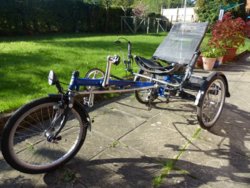Bad Machine
In the garage .....
- Location
- East Anglia
The original thought that I could steer the front fork tube using a notched light bracket was maybe a little naiive. No matter how far the top nut on fork tube is tightened against the bracket and the lock nut below it (this is a 1" threaded headset), there's play when moving the lever forwards and backwards. And I'm not one for carrying a full set of spanners on every ride.
Brazing a levering plate onto the fork's shoulder - as standard on the factory-built older Hase designs - isn't an option. With a crank drive in situ there would need to be a series of bends in the steerer bar that runs between the fork and the underseat handlebar (I've seen how creative standard Kett owners have had to be to navigate around their TSDZ2 or Bafang motors).
The new idea is to use a short reach quill stem at 90 degrees to normal, wedged at an appropriate height in the steerer tube, connecting to a straight tube that can run diagonally down over the crank drive and on to the handlebar fixing. An M5 rivnut locked into the front of the 16mm Al tube connects to the stem through a rose joint pivot; the rear is clamped (via 2 P-clips, a bridge, and either a rose or thrust joint) to the horizontal section of the handlebar.
I've seen that reducing the distance between fork centre and front rose joint increases leverage, but reducing the handlebar centre to clamp gap at the rear will decrease the angle the front wheel turns, and avoids the steerer tube moving too far in or out from the boom. Several variables to play with - I've made my choice and have ordered the various bits and pieces needed, and will await the post.
Brazing a levering plate onto the fork's shoulder - as standard on the factory-built older Hase designs - isn't an option. With a crank drive in situ there would need to be a series of bends in the steerer bar that runs between the fork and the underseat handlebar (I've seen how creative standard Kett owners have had to be to navigate around their TSDZ2 or Bafang motors).
The new idea is to use a short reach quill stem at 90 degrees to normal, wedged at an appropriate height in the steerer tube, connecting to a straight tube that can run diagonally down over the crank drive and on to the handlebar fixing. An M5 rivnut locked into the front of the 16mm Al tube connects to the stem through a rose joint pivot; the rear is clamped (via 2 P-clips, a bridge, and either a rose or thrust joint) to the horizontal section of the handlebar.
I've seen that reducing the distance between fork centre and front rose joint increases leverage, but reducing the handlebar centre to clamp gap at the rear will decrease the angle the front wheel turns, and avoids the steerer tube moving too far in or out from the boom. Several variables to play with - I've made my choice and have ordered the various bits and pieces needed, and will await the post.




